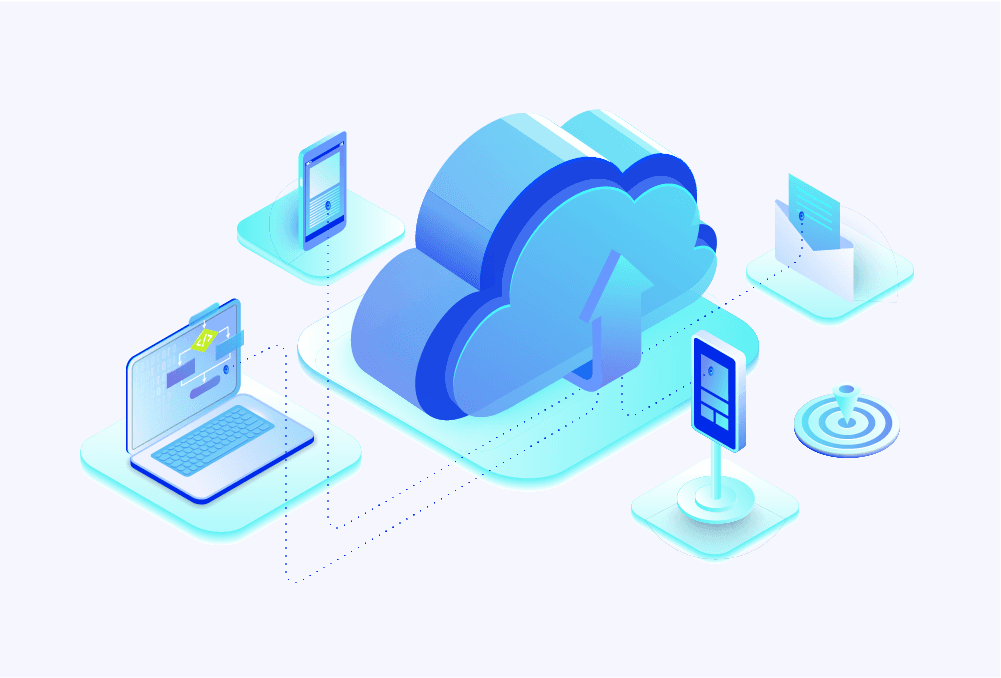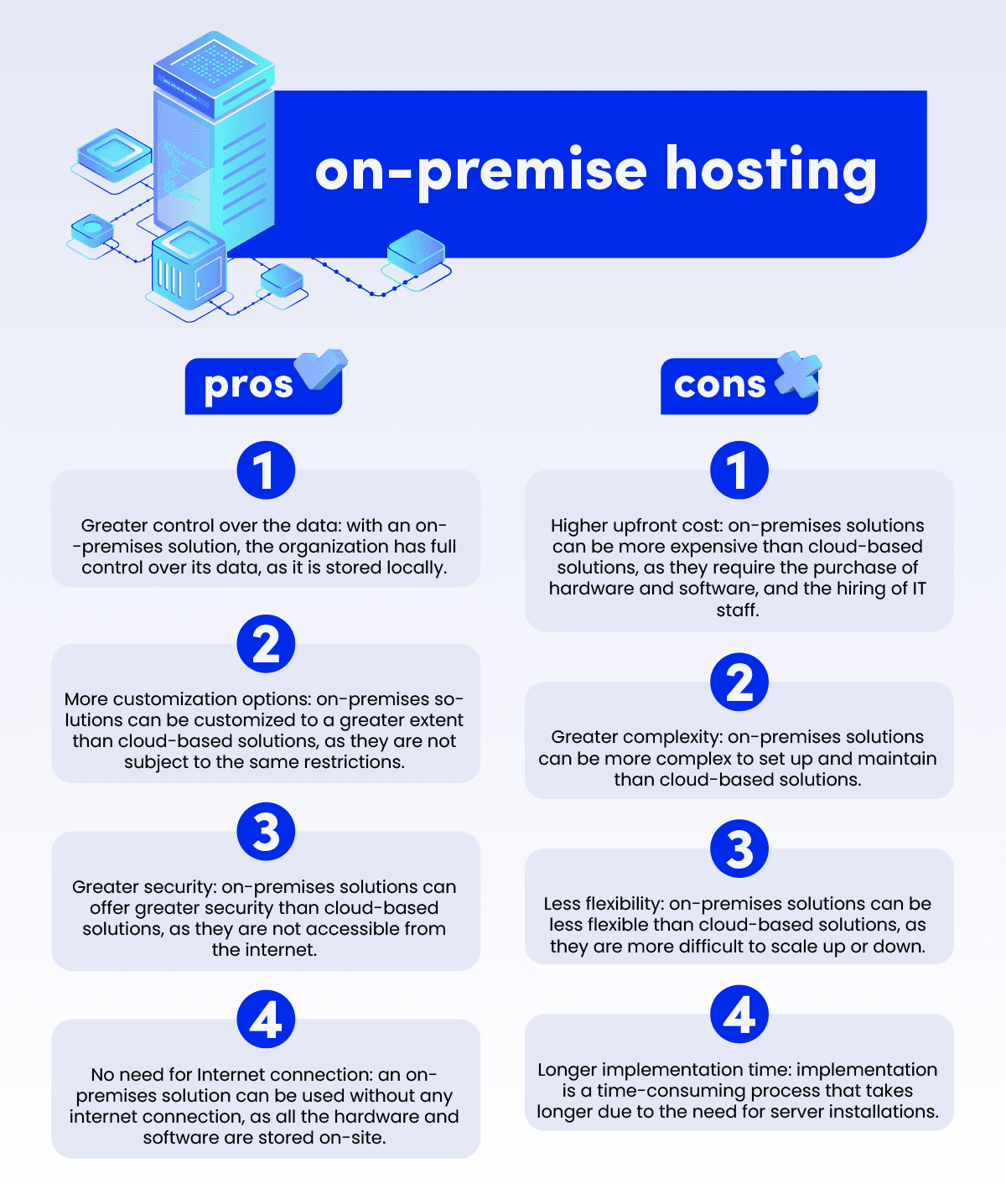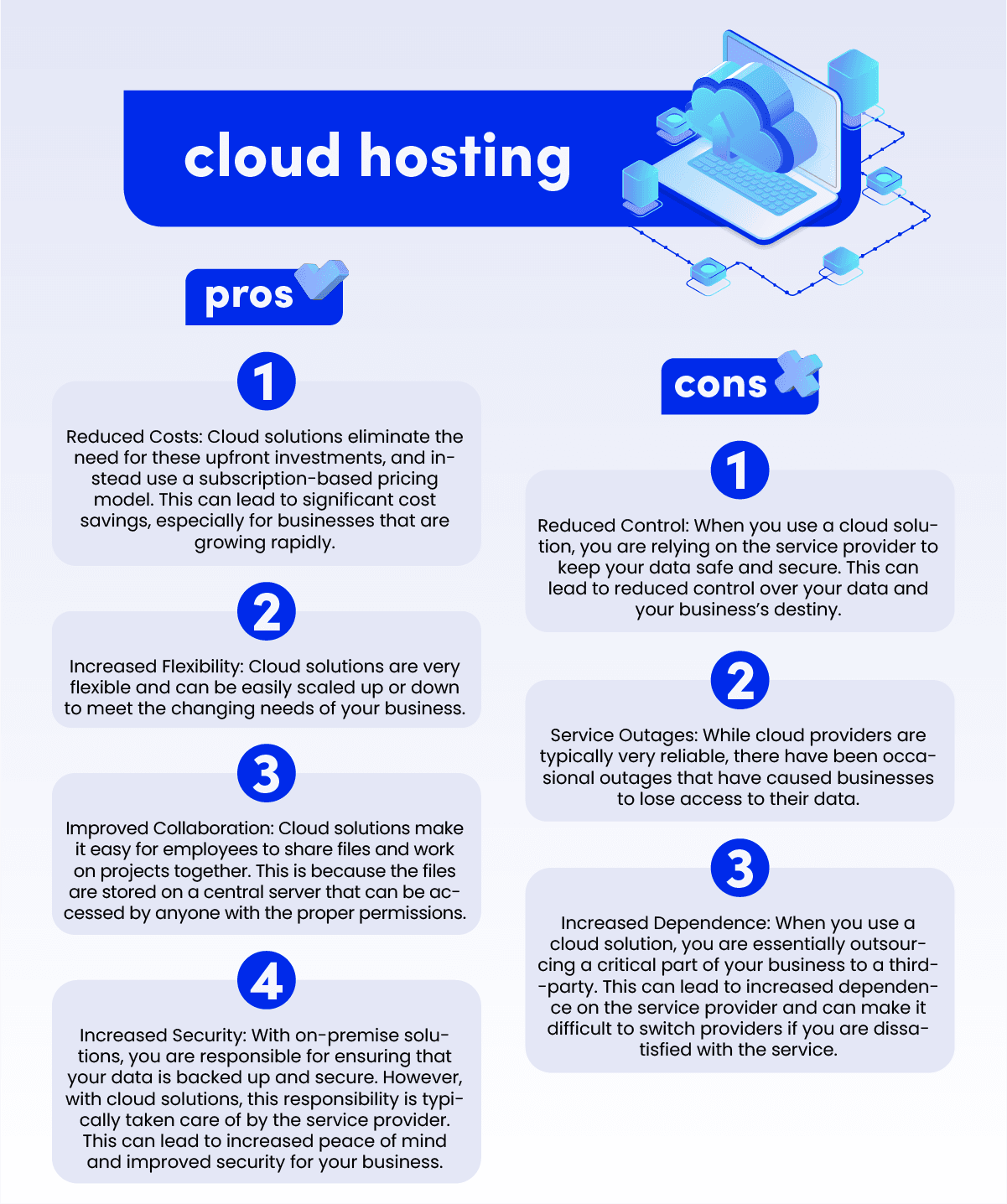The right decision-making in business certainly plays a crucial part in ensuring the most optimal operation. When it comes to software solutions, decisions to be made are coming in nearly every step of the way, whether it’s the project management or the product development itself. We have already covered one dilemma - Custom vs off-the-shelf products.
It’s time to now look at another hot topic. The software deployment/hosting.
It’s nothing else than choosing the way a digital product is bound to be stored. As much as it sounds rather straightforward, there’s quite a bit of hustle in making the best decision. The analysis of business requirements must be done in order to choose between two approaches (given it’s reduced down to the choice between on-prem and cloud). Once this has been decided, one needs to find a reliable technology partner who can provide them with services of varying levels according to their preference. The process for selecting an appropriate strategy starts by determining what type or technologies are most suitable based on the organization’s anticipated needs.
Now, let’s take a closer look at what these two really are.
On-premise - what does it mean and how does it work?
On-premise software deployment means that the software is installed and deployed on the customer's own premises, usually within their own organization. The customer is responsible for managing and maintaining the on-premise software system. On-premise systems can be either physical or virtual.
Virtualization technology has allowed for greater flexibility in on-premise software deployments. With virtualization, customers can run multiple virtual machines (VMs) on a single physical server. This can provide significant cost savings compared to traditional on-premise deployments, where each application would require its own dedicated server.
On-premise software deployments are typically used by organizations that have specific needs that cannot be met by other deployment types, such as SaaS. Organizations that use on-premise software deployments typically have in-house IT staff who are responsible for managing and maintaining the system.
On-premise software deployments are typically more expensive than other deployment types, such as Software as a Service (SaaS). This is because the customer is responsible for all of the costs associated with managing and maintaining the system, including hardware, software, and IT staff. Despite the higher upfront cost, on-premise deployments can provide greater control and flexibility for customers. With on-premise systems, customers can customize the software to meet their specific needs and requirements. They are also not subject to the same level of service outages that can occur with cloud-based systems.
On-premise hosting - benefits and disadvantages
In terms of the benefits of the on-premise solutions, there are:
- Greater control over the data: with an on-premises solution, the organization has full control over its data, as it is stored locally.
- More customization options: on-premises solutions can be customized to a greater extent than cloud-based solutions, as they are not subject to the same restrictions.
- Greater security: on-premises solutions can offer greater security than cloud-based solutions, as they are not accessible from the internet.
- No need for Internet connection: an on-premises solution can be used without any internet connection, as all the hardware and software are stored on-site.
When it comes to the disadvantages, we can differentiate:
- Higher upfront cost: on-premises solutions can be more expensive than cloud-based solutions, as they require the purchase of hardware and software, and the hiring of IT staff.
- Greater complexity: on-premises solutions can be more complex to set up and maintain than cloud-based solutions.
- Less flexibility: on-premises solutions can be less flexible than cloud-based solutions, as they are more difficult to scale up or down.
- Longer implementation time: implementation is a time-consuming process that takes longer due to the need for server installations.
On-premise: pros and cons breakdown
Cloud computing - what does it mean and how does it work?
In its simplest form, cloud computing is the delivery of software and IT services over the internet. This means that instead of having a program installed on your computer or server, you can access it, or store it, ‘in the cloud’.Cloud computing services are provided by specialist providers (known as ‘cloud providers’), who make their services available to customers via the internet. Customers can then access these services as and when they need to, using any internet-connected device.Some of the most popular cloud computing services include:
- Cloud storage: This is where files and data are stored ‘in the cloud’, instead of on your computer or other device. Popular examples include iCloud (used by Apple devices) and Google Drive.
- Cloud backup: This is where your files and data are backed up ‘in the cloud’, as well as (or instead of) on your own computer or other device. This can give you an extra layer of protection in case your computer or device is lost, stolen, or damaged.
- Cloud computing: This is where software and applications are hosted ‘in the cloud’, instead of on your own computer or server. This can include everything from office suites and project management tools to email and customer relationship management (CRM) systems.
- Cloud hosting: This is where websites are hosted ‘in the cloud’, instead of on your own web server.
Cloud computing is a model for enabling ubiquitous, convenient, on-demand network access to a shared pool of configurable computing resources (e.g., networks, servers, storage, applications, and services) that can be rapidly provisioned and released with minimal management effort or service provider interaction.
In general, one can oftentimes meet three service models and four deployment models described for cloud computing.
Cloud computing - service models
Cloud Software as a Service (SaaS): The capability provided to the consumer is to use the provider’s applications running on a cloud infrastructure. The applications are accessible from various client devices through either a thin client interface, such as a web browser (e.g., web-based email), or a program interface. The consumer does not manage or control the underlying cloud infrastructure including network, servers, operating systems, storage, or even individual application capabilities, with the possible exception of limited user-specific application configuration settings.
Cloud Platform as a Service (PaaS): The capability provided to the consumer is to deploy onto the cloud infrastructure consumer-created or acquired applications created using programming languages and tools supported by the provider. The consumer does not manage or control the underlying cloud infrastructure including networks, servers, operating systems, or storage, but has control over the deployed applications and possibly application hosting environment configurations.
Cloud Infrastructure as a Service (IaaS): The capability provided to the consumer is to provision processing, storage, networks, and other fundamental computing resources where the consumer is able to deploy and run arbitrary software, which can include operating systems and applications. The consumer does not manage or control the underlying cloud infrastructure but has control over operating systems, storage, deployed applications, and possibly limited control of select networking components (e.g., host firewalls).
Cloud computing - deployment models
Private cloud: The cloud infrastructure is operated solely for an organization. It may be managed by the organization or a third party and may exist on-premises or off-premises.
Public cloud: The cloud infrastructure is made available to the general public or a large industry group and is owned by an organization selling cloud services.
Hybrid cloud: The cloud infrastructure is a composition of two or more clouds (private, community, or public) that remain unique entities but are bound together by standardized or proprietary technology that enables data and application portability (e.g., cloud bursting for load-balancing between clouds).
Community cloud: The cloud infrastructure is shared by several organizations and supports a specific community that has shared concerns (e.g., mission, security requirements, policy, and compliance considerations). It may be managed by the organizations or a third party and may exist on-premises or off-premises.
Cloud hosting - benefits and disadvantages
When it comes to the benefits of cloud solutions, there are:
- Reduced Costs: Cloud solutions eliminate the need for these upfront investments, and instead use a subscription-based pricing model. This can lead to significant cost savings, especially for businesses that are growing rapidly.
- Increased Flexibility: Cloud solutions are very flexible and can be easily scaled up or down to meet the changing needs of your business.
- Improved Collaboration: Cloud solutions make it easy for employees to share files and work on projects together. This is because the files are stored on a central server that can be accessed by anyone with the proper permissions.
- Increased Security: With on-premise solutions, you are responsible for ensuring that your data is backed up and secure. However, with cloud solutions, this responsibility is typically taken care of by the service provider. This can lead to increased peace of mind and improved security for your business.
Cloud hosting: pros and cons breakdown
However, there are also some disadvantages to using cloud solutions, including:
- Reduced Control: When you use a cloud solution, you are relying on the service provider to keep your data safe and secure. This can lead to reduced control over your data and your business’s destiny.
- Service Outages: While cloud providers are typically very reliable, there have been occasional outages that have caused businesses to lose access to their data.
- Increased Dependence: When you use a cloud solution, you are essentially outsourcing a critical part of your business to a third-party. This can lead to increased dependence on the service provider and can make it difficult to switch providers if you are dissatisfied with the service.
On premise vs cloud - the comparison in short
On-premise software is installed and runs on the company's own servers. This gives the company full control over the software and its data, but it also means that the company is responsible for maintaining and updating the software. On-premise software can be more expensive to set up and run than cloud-based software, but it can offer better security and performance.
Cloud-based software is hosted on the provider's servers and accessed over the internet. This type of software is usually cheaper to set up and run than on-premise software, and it can be easier to scale up or down as needed. However, the company does not have full control over the software or its data, and it is reliant on the provider for maintenance and updates.



